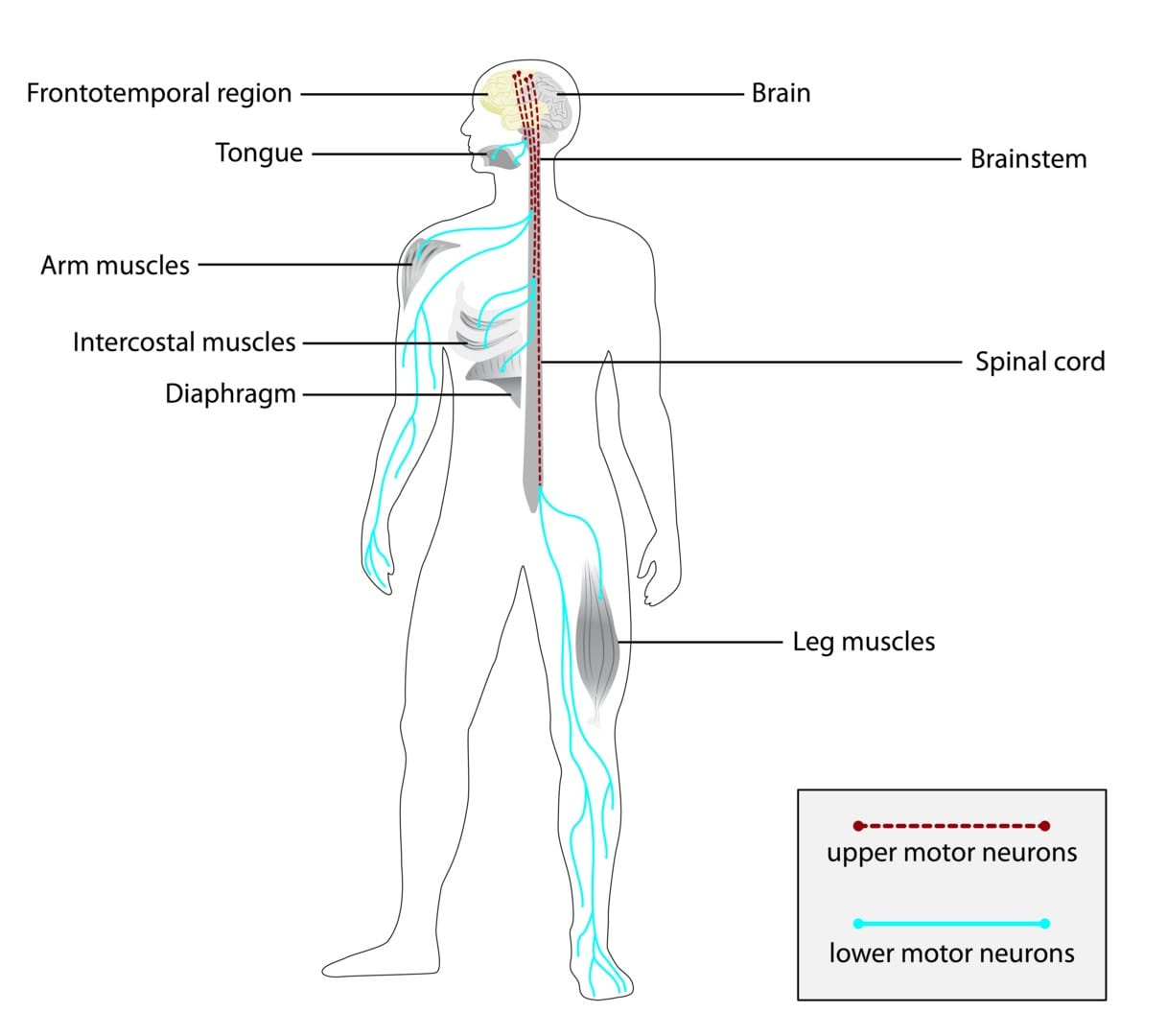Amyotrophic Lateral Sclerosis (ALS), also known as Lou Gehrig’s disease, is a rare, progressive neurological disorder that affects nerve cells in the brain and spinal cord. Over time, the disease leads to the degeneration and eventual death of motor neurons — the nerve cells responsible for controlling voluntary muscles. As these neurons die, the brain’s ability to initiate and control muscle movement is lost, causing individuals with ALS to lose muscle strength and the ability to move, speak, eat, and eventually breathe.
🔬 What Is ALS?
ALS belongs to a group of disorders known as motor neuron diseases (MNDs), which are characterized by the gradual degeneration and death of motor neurons. These neurons are essential for voluntary muscle activities such as walking, talking, chewing, and breathing.
There are two types of motor neurons involved:
-
Upper motor neurons, which originate in the brain.
-
Lower motor neurons, which originate in the spinal cord and brainstem.
ALS affects both types, leading to a complete breakdown of the communication pathway between the brain and muscles.
🧠 Early Symptoms of ALS
ALS typically begins subtly and progresses rapidly. The early signs may vary widely depending on which muscles are affected first. Symptoms usually begin in one part of the body and gradually spread.
1. Muscle Weakness
One of the earliest and most common signs of ALS is muscle weakness. This might manifest as:
-
Trouble lifting things
-
Slurred speech
-
Difficulty walking or climbing stairs
-
Weak grip or dropping objects
2. Twitching (Fasciculations)
Involuntary muscle twitching, especially in the arms, legs, shoulders, or tongue, is often reported early in the disease.
3. Muscle Cramps and Stiffness (Spasticity)
Muscle cramps and tightness are typical in ALS and can cause discomfort and reduced mobility.
4. Slurred or Nasal Speech
The disease can affect the muscles that control speech, leading to slurred, slow, or nasal-sounding speech.
5. Tripping and Falling
As leg muscles weaken, patients may experience frequent tripping, stumbling, or difficulty keeping balance.
📈 Progression of ALS Symptoms
As ALS progresses, symptoms become more severe and widespread. The disease does not affect all people in the same way, but common developments include:
1. Total Muscle Paralysis
Eventually, ALS leads to complete paralysis of voluntary muscles, affecting all movement and physical activity.
2. Difficulty Swallowing and Chewing (Dysphagia)
Swallowing becomes difficult, increasing the risk of choking or aspiration pneumonia, and leading to weight loss.
3. Breathing Problems
As respiratory muscles weaken, breathing becomes labored, especially during sleep. Mechanical ventilation is often required in later stages.
4. Cognitive and Behavioral Changes
While ALS is primarily a motor neuron disease, some individuals may experience frontotemporal dementia (FTD), emotional outbursts, or changes in personality and decision-making.
5. No Effect on Sensory Functions
Notably, ALS typically does not affect:
-
Sensory nerves (sight, smell, hearing, taste, and touch)
-
Bladder or bowel functions
-
Sexual function (in most cases)
🧬 Causes of ALS
The exact cause of ALS remains largely unknown, but research has identified several contributing factors. ALS can be classified into two categories:
1. Sporadic ALS (90–95%)
This is the most common form and appears randomly, with no family history. The causes are unknown but may include:
-
Environmental toxins (e.g., heavy metals, pesticides)
-
Oxidative stress
-
Abnormal immune responses
-
Glutamate toxicity, leading to nerve damage
-
Mitochondrial dysfunction
2. Familial ALS (5–10%)
Inherited ALS is caused by mutations in specific genes. Over 40 genes have been associated with ALS. The most common include:
-
C9ORF72 mutation (most frequent in familial ALS)
-
SOD1 (Superoxide Dismutase 1)
-
TARDBP (TDP-43)
-
FUS (Fused in Sarcoma)
These genetic mutations affect the way proteins are produced or handled in the nerve cells, causing them to misfold, aggregate, and eventually damage the neurons.
🧪 Risk Factors
While ALS can affect anyone, some factors may increase the likelihood of developing the disease:
1. Age
Most people with ALS are diagnosed between the ages of 40 and 70, with peak incidence around age 55.
2. Gender
Men are slightly more likely to develop ALS than women, although the difference diminishes with age.
3. Genetics
Having a family history of ALS significantly raises your risk, especially with known inherited gene mutations.
4. Military Service
Veterans are statistically more likely to develop ALS, possibly due to exposure to environmental toxins, heavy metals, and physical trauma.
5. Smoking
Smoking is one of the few environmental risk factors clearly linked to ALS.
🧭 Diagnosis of ALS
There is no single test to definitively diagnose ALS. Doctors rely on a combination of clinical examinations and diagnostic tools to rule out other conditions.
Common tests include:
-
Electromyography (EMG): Measures electrical activity in muscles
-
Nerve Conduction Studies (NCS)
-
MRI scans
-
Blood and urine tests
-
Spinal tap (lumbar puncture)
-
Muscle biopsy
-
Genetic testing (in familial cases)
Diagnosis may take months due to the need to observe progression and rule out other neurological disorders like multiple sclerosis (MS) or myasthenia gravis.
🧭 Is ALS Curable?
Unfortunately, there is no cure for ALS. However, certain treatments and interventions can improve quality of life, slow disease progression, and help manage symptoms.
FDA-approved medications include:
-
Riluzole (Rilutek): Slightly extends survival
-
Edaravone (Radicava): May slow functional decline
Other supportive care includes:
-
Physical therapy
-
Occupational therapy
-
Speech therapy
-
Nutritional support
-
Non-invasive ventilation (NIV) devices
-
Medications for spasticity, depression, and drooling
💡 Living with ALS
Living with ALS poses extreme challenges, not only for the patient but also for caregivers and families. Multidisciplinary care is essential, involving:
-
Neurologists
-
Respiratory therapists
-
Nutritionists
-
Psychologists
-
Social workers
Many patients benefit from palliative care services and support groups that provide emotional and psychological support.
📊 Prognosis
ALS is progressive and typically fatal. The average life expectancy is 2 to 5 years after diagnosis, but some people live much longer — particularly with advancements in supportive care.
Notable cases include:
-
Stephen Hawking, who lived with ALS for over 50 years.
-
Lou Gehrig, the legendary baseball player who brought the disease into the public eye.
🧠 Final Thoughts
Amyotrophic Lateral Sclerosis is a cruel and complex disease that remains poorly understood. While medical science has made progress in understanding its genetic and biological underpinnings, a cure remains elusive.
Greater awareness, research funding, and compassionate care are vital in the fight against ALS. Until a cure is found, the focus remains on enhancing quality of life and providing support for those affected by this relentless condition.













